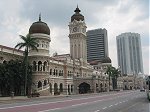 |
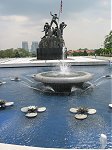 |
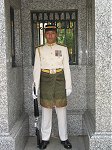 |
 |
North Island
After almost 1 1/2 years of preparations we finally flew to New Zealand with a short one night stopover in Kuala Lumpur. In KL we made a city tour which brought us to several places, e.g. the Sultan Abdul Samad building, the national monument, the royal palace and the very high Petronas twin towers.
We started in Auckland where we stayed with friends in one of Auckland's suburbs. The Waitakere ranges with the Arataki Maori museum and Piha beach are two of the nice areas around the big city of Auckland.
 |
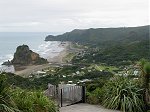 |
N.B. If you travel to New Zealand don't forget to buy a Yabba telephone card. With this card you can phone at local tariffs all over New Zealand and you can also make cheap phone calls to many other countries, e.g. 30 ct/minute to the Netherlands. Much cheaper than using your mobile or cell phone.
Leaving Auckland we drove via Waiwera and Whangarei in 1 1/2 days to romantic Russell where we crossed the Bay of Islands by ferry to more sophisticated Paihia. Very soon we noticed that roads in New Zealand are most of the times two lanes with narrow one lane bridges, they are often winding with steep hills and secondary roads are also narrow and/or made of gravel; having at least a 1,300 cc car is a must.
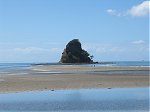 |
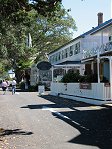 |
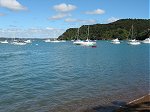 |
In Paihia we made a Fullers boat cruise to the nice Cape Brett hole in the rock. On your way you may see dolphins, albatrosses and you certainly will see a lot of islands.
Our way leaded from the Bay of Islands north to Mangonui and Doubtless Bay, 90 Miles beach and south again via the west coast to the beautiful dunes at Hokianga harbour.
From the hill near Mangonui you have a wonderful view over the bay. You are only allowed to drive on the 90 miles beach if you have a 4-wheel drive car. If you come from the north you can cross Hokianga harbour in Rawene. A little bit further southwest is the lookout point on Pakia hill.
Continuing south you pass the Waipoua kauri forest not too far from Dargaville. This forest has two of the largest, 1,200 to 2,000 years old kauri trees, one of them standing very close to the road, i.e. Tane Mahuta.
 |
Towards Coromandel peninsula you pass Auckland again. The peninsula is very beautiful with white sandy beaches. The road between Coromandel town and Whitianga is very steep and winding but with beautiful views either on Coromandel harbour or on the South Pacific ocean. A bit further south is Whangamata with its lovely beach. We stayed in the very nice Breakers motel where we had an great apartment with our own private outdoor spa pool, a nice swimming pool and fine barbecue.
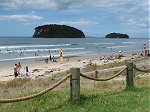 |
 |
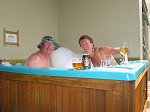 |
Rotorua is the heart of the North Island and is famous for all its thermal activities. Bubbling mud pools, hot springs, geysers, a nice lake with loads of trout and black swans and an always noticeable evil eggy smell. Thermal activities can also be found in Whakarewarewa, e.g. the Pohutu geyser, and at Hell's gate.
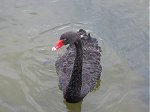 |
 |
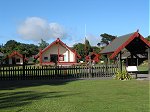 |
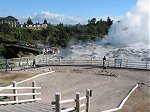 |
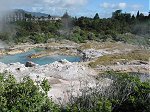 |
 |
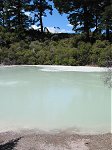 |
If you can spend some extra money it is worth to fly in a floatplane over the lake, the thermal places and the huge Tarawera crater.
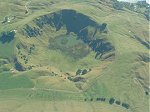 |
 |
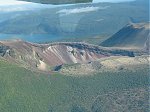 |
At night you can have dinner with the Maori people during a "hangi". An official welcome ceremony during which smiling or laughing is absolutely forbidden, comes first before you are allowed to enter the village and have dinner.
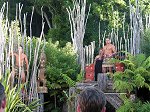 |
If you leave Rotorua in the direction of Taupo you pass another thermal area, i.e. Wai-o-tapu with many interesting features like boiling mud pools, opal pools, champagne pool etc. Quite close is the very touristy Lady Knox geyser which spouts off every morning punctually, activated by one of the park guards. Though manually started it still is a spectacular view.
 |
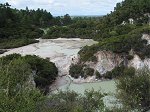 |
 |
Further south you should not miss the beautiful Huka falls. Giant rapids that plunge through a narrow gorge. A little boat can bring you close to the rapids. The city of Taupo and Lake Taupo are nearby. We passed the lake and stayed in Turangi, south of the lake, very near Tongariro National Park.
Tongariro is famous for its three volcanoes: Mount Tongariro, Mount Ruapehu and Mount Ngauruhoe, better known as Mt Doom in the Lord of the Rings trilogy. At fine weather as we had you have stunning views on all three of them. From Turangi a tour around the national park with several stops can easily be done in a day. If you like to make one or more walks you will have to stay over e.g. in Ohakune or Whakapapa village.
 |
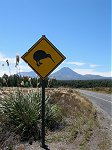 |
The road from Turangi to the west coast is not easy everywhere. Near Ohura it changes into a very slippery gravel road. But when you arrive at the coast you will come to a good highway again. Before you reach New Plymouth you can make a short detour to the White cliffs and soon afterwards you arrive at New Plymouth, one of New Zealand's bigger cities. For beautiful views of Mount Egmont or Taranaki, drive in the direction of Stratford and about 10 km south of New Plymouth you will find Lake Mangamahoe, where, at nice weather, Mt Egmont may reflect in the waters of the lake.
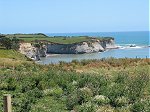 |
 |
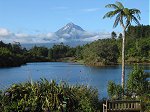 |
In Wanganui a trip with the semi-old side-paddle steamer Waimarie is a nice break in the journey to Wellington.
Wellington, capital of New Zealand, is a big city with huge buildings, the parliament buildings like the Beehive and a lovely cable car that brings you up the steep hill from Lambton Quay to Kelburn from where you have a great view over the city.
Wellington was our last stop on the North island. The Interislander ferry took us over to the South Island.
South Island
To see marine animals in their natural environment is the main reason to visit Kaikoura. Dolphins, seals and above all one of the largest animals on earth, the sperm whale. We saw them from the air and from the sea and both trips are worth every dollar they cost. There is no guarantee that you will see all these animals, but some of them will be present. Seals you will undoubtedly see around Kaikoura.
It is a long drive from Kaikoura to Westport at the west coast, but the scenery is beautiful. The Westport motels offer nice rooms and a lovely separate spa pool. On your way from Westport to Franz Josef Glacier you pass the nice Pancake rocks and blowholes in Punakaiki. These limestone rocks look like stacks of thin pancakes.
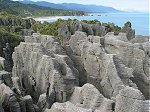 |
In Franz Josef we had our first disappointment so far during this holiday. The evening we arrived it started to rain and the next day for which we had booked our helicopter flight we could see the mountains only very briefly, so the flight was cancelled.
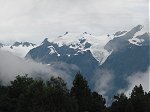 |
Instead of flying we drove via the Franz Josef and Fox glaciers to the tiny village of Haast and the next day we continued along the large lakes of Wanaka and Hawea to Queenstown. Before arriving in Queenstown the village of Arrowtown with its 19th century houses is worth a visit. Queenstown is on the northern shore of Lake Wakatipu where the old famous steamer TSS Earnslaw is one of the cruise boats. Queenstown is one of the bigger cities of the country too as you can see from the photo from Bob's peak.
Te Anau is on the southern shore of Te Anau lake and though it is a nice village it is mainly used as a jumping-off point for Milford and Doubtful Sounds. Due to lack of time we could only see one of them and we chose for the Milford Sound. On the way to the sound there are several interesting points to stop for, like Knobs Flat and the Mirror lakes.
 |
 |
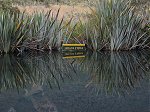 |
When you have passed the narrow and low Homer tunnel, the steep descent to the sound follows. At the sound you can board on one of the Red boats and have a cruise on the sound. Bring some warm clothes and some protection against rain, since normally it rains here almost every day with an average rain fall of 7 metres a year. However, when we were there it hadn't rained for six days and a lot of the waterfalls had dried up, though some major ones were still falling down.
 |
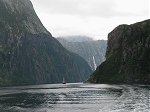 |
 |
Before you reach the very interesting underwater observatory the boat will pass the seals rock. We were really wondering how they manage to climb such a steep rock.
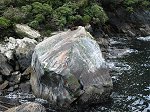 |
Don't miss the observatory: you can see some rare species there. Since the cold rainwater above the warmer seawater absorbs much of the sunlight, the waters of the sound replicate deep-ocean conditions. As a result plants and animals, e.g. black coral and some shells which normally live in deeper water can be seen here not far below the surface.
Bluff, port of Invercargill, is one of the most southern places in New Zealand. At Land's end a sign post shows the distances to some big cities in the world. It is funny to have been there, but apart from two nice restaurants with great views over the ocean, not much of any importance can be found there.
However, the Catlins National Park, north of Invercargill, has many interesting sights, like Curio Bay, where fossil trees from the Jura era can be found at low tide. And everywhere in the country you can see meadows with lots of sheep and nice flowers.
Nugget Point is another interesting place. The road to the top is narrow and made of gravel again and if there is a lot of traffic as we had, it is a bit dangerous to drive up, but from the top the view is great and if you dare to walk down you can see fur seals, perhaps sea lions and/or elephants seals and penguins.
We drove through the centre of Dunedin and saw some of the highlights as the nice Octagon square with many terraces, the old station and the steepest street in the world, Baldwin Street.
In Oamaru you can see the blue penguins coming out of the water after sunset. Unfortunately, but understandably, photography or video is forbidden. It is very funny to see them "socializing" and looking for each other. After they have dried up they go to their nests.
From Glentanner on the southern shore of Lake Pukaki we drove along the lake to Mt Cook Village, where we stayed in one of the A-shaped chalets of the most famous hotel in New Zealand, the Hermitage hotel. We hoped to make a helicopter flight around Mt Cook. However, the day we arrived it stormed and rained terribly. But the next day the weather had improved and though in the early morning Mt Cook had some clouds around, we later had the most blue and clear sky you can wish.
 |
 |
The helicopter flight started in Glentanner, so we had to drive back along Lake Pukaki.
 |
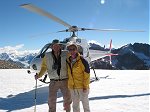 |
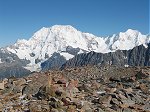 |
After the short stop on one of the glaciers we continued our flight around Mt Cook and if you have a very good look at the next photo you can see the sea at the west coast. One of the glaciers might be the Fox glacier on the next photo.
From Glentanner it is only a short drive to Lake Tekapo. During the trip views on Mt Cook and the other Alps mountains remain to be great. But also Lake Tekapo and its Church of the good Shepard are worthwhile.
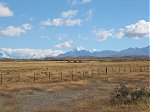 |
 |
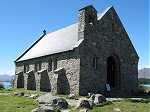 |
Christchurch was our last stop in New Zealand. The Gondola took us up Mt Cavendish from where we had a good view over the city and its port Lyttelton. It is best to buy a combined ticket for the Gondola and the trams. You don't have to use it the same day; you can go on the Gondola one day and on the tram the next day.
|
|
In the city centre since many years the eccentric Wizard tells his truth to a lot of listeners every day. His photo will most likely be in everyone's photo book. The old, early 20th century, restored trams make their 2 1/2 km rounds through town, officially starting at Cathedral square.
The trams make stops along their way, e.g. at the Botanic Gardens and near the Avon river where you can hire a punter to row you over the river. And almost at the end of their roundtrip you can have lunch in the nice New Regent Street, once THE shopping mall of Christchurch.
After 5 1/2 weeks our holiday had come to an end. We had a great time and will certainly go back to New Zealand one day.
last revision: 1 March 2006
Jaap & Marion Fahrenfort-Nietfeld